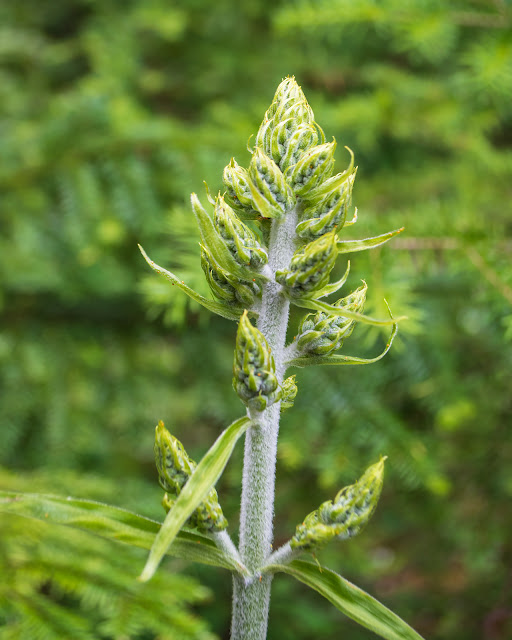Looking at trail maps around the Campbell River, I saw a photo of a pedestrian (one at a time) bridge high over the river, a bridge not marked on most of the trail maps, but there was this one photo. I had to go see it.
 |
| The bridge from the first vantage point. |
The trail starts at the
John Hart generating station, and at first goes through walled-off alleys between the river and the station; there's an open spot with benches, photos of the underground workings, and totem poles, and then more alleys, with a hidden entrance. Once around the corner, though, you come out to a view of the river. And a staircase, a couple of hundred steps going up the hillside, flanked by blackberry bushes. Then a trail, still climbing. A short drop, a curve, and the bridge over a narrow canyon at the bottom. Then the trail goes on, climbing again. I stopped at the bridge.
 |
| And what's that down there in the water? |
 |
| Some sort of spinning device, anchored in mid-stream. |
The river is narrow and shallow here, since most of the water is piped through the station's three generators. But the water level is lower, too; you can see the white, scoured rock where the water reaches in wetter seasons.
But what is that spinning thing?
~~~~~~~~~~~~~~~~~~~~~
Viendo mapas de senderos alrededor del rio Campbell, encontré una foto de un puente que no había visto; un puente para peatones, un puente angosto, donde hay que pasar en fila. Pues tenía que ir a verlo.
Primera foto: el puente desde el primer lugar donde salió a la vista.
El camino empieza en la planta hidroeléctrica John Hart, y al principio pasa entre paredes que esconden tanto la planta como el rio. Luego hay un area con asientos, fotos informativos sobre la planta subterránea, y postes tótem; después sigue el camino entre paredes por un poco, y por fin salimos a campo abierto. Y a una escalera que sube el cerro; unos doscientos escalones. Luego un sendero sigue subiendo, una curva, y allí abajo está el puente. El camino sigue, subiendo aun; yo allí me detuve.
Segunda foto: La vista desde el puente, mirando rio abajo. Los edificios que se ven tras los árboles son los de la planta generadora.
Tercera foto: la vista desde el centro del puente, mirando rio arriba.
Cuarta: desde el final del puente.
Me salí del camino para subirme a las rocas para una mejor vista del rio. Y desde allí, pude ver más allá de la curva en el rio.
Quinta y sexta fotos: ¿Y qué es esa cosa que gira y gira allí abajo?
El rio es angosto y lleva poca agua aquí; la mayor parte del agua se ha desviado hacia las tres generadores de la planta subterránea. Pero en esta temporada, también el nivel del agua ha bajado; se ve la roca blanca que en otras temporadas estaría cubierta de agua.
¿Pero, qué sería esa cosa en el agua?






















































